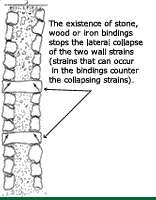Stone
Masonry Walls
|
|
|||
|
Not cut or common (normal), are walls made of rough, angular and irregular in shape and dimension stones, or rolled stones, held together by normal mortar. This type of construction is spread all over the country, but prevails in the centre and in the Lisbon area. Probably because this kind of material is abundant and found in demolitions. It is usally plastered and whitewashed to protect it from atmospheric agents, namely water. CutIn perpend - that is regular, and cut to the effect, layed and held together by mortar or simply put one on top of the other. Masonry all the widht of the wall, with the four sides cut. Mainly in the north of the country, and visible. Wall of mortar stone, usually irregular and angular shaped, layed in two layers, one internal and the other external, filled in between by small size material, with commom mortar. They were braced with wooden or iron links that crossed the wall, preventing lateral collapse.
|

  Not cut rolled stones  Angular stones irregularly layed with one side cut  Parcial cut stones layed in several layers  Perpend
Perpend
|
||||||||||||||||||||||||||||||||||||||||
© 2002 - 2025 Paulo
Jones
|